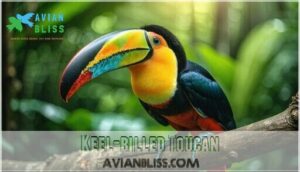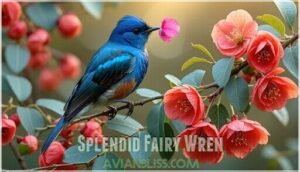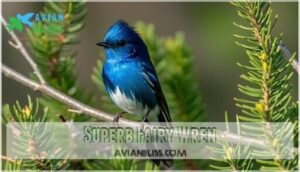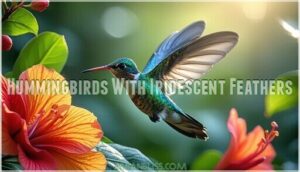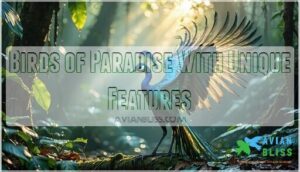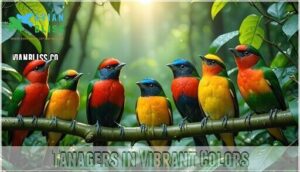This site is supported by our readers. We may earn a commission, at no cost to you, if you purchase through links.

From the toucan’s neon-bright bill to the peacock’s shimmering tail display, these aerial artists sport color combinations that’d make a paint store jealous.
Think electric blues on fairy wrens, sunset oranges on painted buntings, and metallic greens that shift like liquid jewels on hummingbirds.
Each species has evolved its own signature palette, whether it’s for attracting mates, confusing predators, or simply showing off.
These living kaleidoscopes prove that Mother Nature definitely wasn’t playing it safe with her color choices, creating aerial artists with signature palette that are truly dazzling artwork.
Table Of Contents
- Key Takeaways
- Toucans and Their Vibrant Bills
- Wrens With Stunning Plumage
- Finches in Brilliant Colors
- Hummingbirds With Iridescent Feathers
- Peacocks and Their Magnificent Tails
- Rollers With Acrobatic Displays
- Birds of Paradise With Unique Features
- Tanagers in Vibrant Colors
- Quetzals With Flowing Tail Feathers
- Other Multicolored Wonders
- Frequently Asked Questions (FAQs)
- What colors do mixed-color birds come in?
- What are the most colorful birds in the world?
- Which bird has the most colorful feathers?
- What bird has a bright plumage?
- Are there multicolored birds native to polar regions?
- How is plumage color formed in birds?
- What is a multicolored bird called?
- What is the name of the bird that has many colors?
- Which bird is rainbow in color?
- Which birds have more than one color?
- Conclusion
Key Takeaways
- You’ll find nature’s most vibrant displays in specific bird families – toucans sport rainbow bills, peacocks flash iridescent tails, and hummingbirds shimmer with metallic greens and blues that change as they move
- These brilliant colors serve evolutionary purposes beyond beauty – males use bright plumage to attract mates during breeding season, while some species use vivid colors to confuse predators or establish territory
- Multicolored birds inhabit diverse ecosystems worldwide – from Australia’s electric-blue fairy wrens to Central America’s emerald quetzals, you’ll discover these living rainbows across tropical rainforests, temperate woodlands, and grasslands
- Bird coloration comes from both pigments and light reflection – species like flamingos get pink from carotenoids in their diet, while others create blues and greens through microscopic feather structures that bend light like tiny prisms
Toucans and Their Vibrant Bills
You’ll be amazed by toucans and their incredible rainbow-colored bills that look almost too colorful to be real.
Prepare to be dazzled by toucans’ bills—nature’s most vibrant rainbow, splashed across a single, spectacular beak!
These tropical showstoppers use their massive, lightweight beaks not just for reaching fruit but also for regulating body temperature and attracting mates.
Keel-billed Toucan
Looking at the keel-billed toucan, you’ll discover one of tropical birds’ most striking exotic bird species.
This colorful bird captivates bird photography enthusiasts with its rainbow bill – a marvel of Bill Composition that’s surprisingly lightweight yet strong.
Here’s what makes keelbilled toucans amazing:
- Toucan Diet includes fruits, insects, and small reptiles
- Social Behavior involves playful bill-fencing with mates
- Conservation Status faces threats from Habitat Loss
- Their bills regulate body temperature like natural air conditioners
These tropical rainforest gems prove nature’s artistic brilliance.
Toco Toucan
The Toco Toucan takes center stage as South America’s most recognizable exotic bird species.
This tropical bird’s massive orange bill can stretch nearly 8 inches—that’s one-third of its body length!
Found throughout Toco Habitat regions like Brazil’s Pantanal, these colorful feathers create stunning contrasts against dense rainforest canopies.
Their vibrant plumage, like that of the scarlet macaw’s colors, aids in communication and camouflage.
- Toco Anatomy: Their oversized bills help regulate body temperature and reach distant fruit
- Toco Diet: Primarily fruit-eaters, they’ll snack on eggs and small reptiles when opportunity knocks
- Toco Behavior: Social creatures that communicate through croaking calls and bill-rattling displays
Wrens With Stunning Plumage
You’ll find that wrens aren’t just small brown birds hiding in bushes—some species showcase breathtaking rainbow colors that rival any tropical bird.
The fairy wrens of Australia prove this point perfectly, with males displaying electric blue plumage so vibrant it almost seems unreal in the wild.
Splendid Fairy Wren
Nothing beats the electric blue brilliance of Australia’s Splendid Fairy Wren when breeding season arrives.
These tiny multicolored birds transform from dull brown into stunning cobalt masterpieces with iridescent feathers that shimmer like jewels.
Males court females by presenting colorful petals—nature’s bouquet delivery service! Their vibrant plumage makes them standouts among Australian birds.
These woodland inhabitants hunt insects and spiders while dodging cats and hawks.
Despite habitat pressures, their conservation status remains stable, proving these feathered gems know how to survive.
Superb Fairy Wren
While the Splendid Fairy Wren dazzles with blues, the Superb Fairy Wren takes brilliance to another level across Australia’s woodlands and scrublands.
These tiny dynamos showcase nature’s artistry through their stunning transformations and complex Social Behavior.
During breeding season, males develop electric blue Male Plumage with black accents that’ll make your jaw drop.
Their Breeding Habits include cooperative parenting, where multiple birds help raise chicks.
These multicolored birds prefer dense shrubland Habitat Preference, though their Conservation Status remains stable thanks to adaptability.
- Watch males court females with bright yellow petals like tiny florists
- Marvel at their iridescent feathers that shimmer like jewels in sunlight
- Discover how family groups work together raising young
- Spot their acrobatic vibrant plumage darting through undergrowth
- Appreciate Australia’s living rainbow gems
Finches in Brilliant Colors
You’ll be amazed by how these small songbirds pack such incredible color combinations into their tiny frames.
Finches showcase some of nature’s most stunning paint jobs, from the rainbow-striped Gouldian finch to the brilliantly mixed hues of painted buntings.
Gouldian Finch
Australia’s Lady Gouldian Finch shows off nature’s artistic genius with their explosive rainbow plumage.
These colorful birds sport black, red, or yellow heads paired with vibrant bodies featuring purple chests and green backs.
| Feature | Details |
|---|---|
| Gouldian habitat | Australian savanna woodlands |
| Finch diet | Grass seeds, insects |
| Breeding Gouldians | Social flocks of hundreds |
| Gouldian mutations | Three distinct head colors |
Their vibrant plumage makes proper finch care essential for captive bird species, as illegal trapping threatens wild populations.
Painted Bunting
Meet North America’s most celebrated colorful birds – the Painted Bunting.
You’ll spot these multicolored birds across the southeastern states, where males flaunt rainbow plumage that’d make peacocks jealous.
Their Diet Diversity includes grass seeds and insects, while Bunting Behavior involves territorial singing from treetops.
Plumage Variations show females sporting olive-green feathers for camouflage.
Their Habitat Range spans brushy areas and woodland edges, though Conservation Status remains stable despite habitat loss concerns.
Lazuli Bunting
Though the Painted Bunting captivates with rainbow colors, the Lazuli Bunting showcases focused brilliance with its sapphire-blue head and rusty breast band.
You’ll find these North American birds migrating between western breeding grounds and Mexican wintering areas, adapting their Bunting Diet from seeds to insects seasonally.
- Plumage Variations include males’ vibrant blue upperparts contrasting with white bellies, while females display warm brown tones
- Lazuli Habitat preferences include brushy hillsides, streamside thickets, and oak woodlands where they build cup-shaped nests
- Bunting Behavior features complex territorial songs and acrobatic courtship displays that make bird identification easier during breeding season
Hummingbirds With Iridescent Feathers
You’ll discover that hummingbirds are nature’s living jewels, with feathers that shift and shimmer like tiny rainbows as they catch the light.
Hummingbirds flash like living gemstones, their iridescent feathers creating rainbow magic with every wingbeat.
These incredible birds can flash brilliant emeralds, deep purples, and fiery oranges all in one quick movement, making them some of the most dazzling creatures you’ll ever see, with their ability to display brilliant colors.
Fiery-throated Hummingbird
You’ll witness Costa Rica’s fiery-throated hummingbird blazing through cloud forests like a living rainbow.
This multicolored bird’s vibrant plumage shifts from emerald green to brilliant orange-red along its throat.
Diet consists mainly of nectar from tubular flowers, while behavior includes territorial displays that showcase their stunning colors.
Habitat spans mountain slopes where conservation efforts protect these jewel-toned hummingbird species from deforestation threats.
Owners can find hummingbird-themed products online.
Violet Sabrewing
Through Sabrewing Habitat in Central America’s cloud forests, you’ll discover the Violet Sabrewing, one of nature’s most spectacular multicolored birds.
This hummingbird’s Sabrewing Morphology features stunning iridescent feathers that shimmer with ultraviolet brilliance.
Sabrewing Behavior includes impressive aerial courtship displays, while their Sabrewing Diet consists primarily of nectar from forest habitats.
Sabrewing Conservation efforts focus on protecting their delicate ecosystems.
These colorful feathers truly make them remarkable.
Black-backed Dwarf Kingfisher
While the Violet Sabrewing impresses with sheer size, the Black-backed Dwarf Kingfisher captivates through miniature perfection.
This colorful birds species measures just 5 inches yet packs stunning feather colors into its tiny frame.
Their Kingfisher Habitat preferences include:
- Dense Southeast Asian forests with streaming water
- Elevated perches near small ponds and clearings
- Shaded tropical woodlands up to 4,000 feet
- Protected riparian zones with abundant insect prey
Their Kingfisher Diet includes insects and small vertebrates, making them efficient forest hunters despite their Dwarf Species status.
Peacocks and Their Magnificent Tails
When you spot a peacock spreading his spectacular tail, you’re witnessing one of nature’s most impressive displays of beauty and evolutionary engineering.
These magnificent birds don’t just show off their colorful feathers for fun—they’re actually using their elaborate plumage to attract mates and establish dominance in their social groups.
Indian Peafowl
You’ve witnessed hummingbirds’ tiny brilliance, but Indian Peafowl bring grandeur to multicolored birds.
These colorful birds transform your understanding of avian beauty through spectacular displays.
- Peacock Courtship involves males spreading 200+ iridescent feathers in mesmerizing fan displays
- Feather Colors shift from emerald to sapphire through microscopic structures reflecting light
- Mating Rituals include rhythmic dancing and haunting calls echoing through their Bird Habitat
- Peafowl Diet of insects, seeds, and fruit fuels their energy for these elaborate performances
These bird species prove nature’s most stunning artistry lives in Southeast Asia’s forests and grasslands.
Congo Peafowl
While Indian Peafowl dazzle across Asia, Africa’s Congo Peafowl offers its own stunning display.
You’ll find these multicolored birds in dense Congo Habitat, where males showcase deep blue iridescent feathers with metallic green necks. Females wear rich brown plumage for camouflage.
Bird Conservation efforts protect this rare bird species whose Peafowl Diet and Avian Behavior remain mysterious in their challenging forest home.
| Feature | Male | Female |
|---|---|---|
| Length | 64-70cm | 60-63cm |
| Feather Colors | Deep blue, metallic green | Chestnut brown |
| Special traits | Bare red neck | Black abdomen |
Rollers With Acrobatic Displays
You’ll be amazed by rollers, the acrobatic performers of the bird world who tumble through the sky in spectacular aerial displays.
These colorful birds combine stunning multicolored plumage with incredible flying skills that’ll leave you watching in wonder.
Lilac-breasted Roller
The Lilac-breasted Roller captivates birdwatchers with its stunning display of colors and aerial stunts.
This vibrant plumage showstopper from the Coraciidae family transforms African skies into living art galleries.
Key features that make this colorful bird species remarkable:
- Roller Habitat: Prefers open savannas and woodlands across Eastern and Southern Africa
- Vibrant plumage: Sports lilac throat, turquoise belly, and russet back feathers
- Roller Diet: Hunts insects, arthropods, and small rodents from elevated perches
- Nesting Behavior: Excavates burrows in termite mounds or tree holes
- Feather Care: Maintains iridescent colors through regular preening and dust baths
European Bee-eater
You’ll spot these colorful birds across southern Europe and Africa, where European Bee-eaters showcase stunning green, yellow, and rust feather colors.
Their multicolored appearance makes them standout exotic birds, while their incredible aerial hunting skills and nesting behaviors in sandy banks demonstrate perfect adaptation to their Bee Eater Habitat during European Migration.
The study of European Bee-eater bird products reveals fascinating insights into their behavior and ecology, which can be further explored through European products.
Indian Roller
Why not witness nature’s most spectacular aerial show? The Indian Roller transforms ordinary roller habitat into a theater of acrobatic flights during breeding season.
This colorful bird’s vibrant plumage showcases brilliant blues and browns that shimmer during bird migration.
Their dramatic nesting behavior includes death-defying dives and rolls that’ll leave you breathless – truly one of the most exotic birds on any bird species list.
The Indian Roller’s distinctive colors can be compared to those of red headed birds regarding their striking appearance.
Birds of Paradise With Unique Features
You’ll discover that birds of paradise showcase some of nature’s most extraordinary combinations of color, pattern, and form.
These tropical gems from New Guinea and surrounding regions display features so unique they seem almost otherworldly, with males performing elaborate dances to show off their spectacular plumage.
Wilson’s Bird of Paradise
Wilson’s Bird of Paradise puts on nature’s most enchanting show with its elaborate ritual dance.
This small Indonesian gem displays vibrant Paradise Feathers – iridescent blue-green plumage with striking red flanks.
Males transform into living rainbows during Mating Rituals, attracting females through mesmerizing Courtship Displays:
- Perch-hopping between branches with athletic precision
- Rapid feather vibrations creating shimmering light effects
- Sickle-shaped tail choreography in dense Bird Habitat undergrowth
- Vocalizations accompanying their acrobatic performances
Wilson’s Bird of Paradise ranks among colorful birds showcasing evolutionary artistry through Colorful Plumage.
The bird’s unique characteristics, such as its feathered body structures, play a vital role in its ability to attract mates and survive in its environment.
Raggiana Bird of Paradise
While Wilson’s Bird of Paradise captivates with its compact elegance, the Raggiana Bird of Paradise commands attention as Papua New Guinea’s national bird.
This spectacular species transforms courtship into pure artistry through elaborate Bird Courtship displays.
4 breathtaking features that’ll make you gasp:
- Flamboyant Paradise Feathers – Males sport brilliant red, yellow, and orange Plumage Colors with flowing filamental plumes
- Competitive lek gatherings – Multiple males perform synchronized displays in Raggiana Habitat
- Rigid wing poses – Dramatic shaking movements that showcase their colorful birds status
- Sexual dimorphism – Males vastly outshine females in vibrant coloration
King Bird of Paradise
You’ll find the King Bird of Paradise strutting through New Guinea’s lowland forests with unmatched flair.
This 25cm showstopper sports vibrant plumage and paired tail wires ending in radiant discs.
During Bird Mating season, males perform acrobatic aerial displays, extending their Paradise Feathers dramatically.
Their Bird Courtship rituals involve precise choreography that’ll captivate any birdwatching guide enthusiast seeking rare bird sightings of these colorful birds with extraordinary King Plumage.
Tanagers in Vibrant Colors
Tanagers showcase nature’s most brilliant color combinations, making them jewels of the bird world you’ll want to spot in tropical forests.
These medium-sized songbirds paint the canopy with their striking reds, blues, greens, and yellows that seem almost too vibrant to be real, and are a key part of the tropical forests.
Red-necked Tanager
You’ll discover that Red-necked Tanagers are nature’s living rainbows, featuring brilliant scarlet necks that’ll make your jaw drop.
These vibrant plumage masters call Eastern South America home, thriving in lush rainforest canopies where habitat conservation matters most.
Their colorful birds status isn’t just for show – those feather colors help with species recognition during bird migration seasons.
Here’s what makes these Rednecked Tanager specimens special:
- Fruit Diet Specialists – They’re basically flying fruit connoisseurs, supplementing with insects for protein
- Nesting Behavior – Build cup-shaped homes high in forest canopies for protection
- Bird Colors Evolution – Their striking red necks evolved differently from their Scarlet Tanager cousins
Paradise Tanager
The Paradise Tanager brings pure magic to South America’s Amazon Basin with its stunning color patterns. You’ll spot its lime-green head contrasting beautifully with its sky-blue belly and vibrant plumage.
These colorful birds thrive in their Paradise Habitat, where feather care keeps their rainbow birds appearance pristine. Their Tanager Diet includes insects and fruit, supporting their energetic lifestyle throughout the rainforest canopy.
| Feature | Details | Conservation Status |
|---|---|---|
| Size | 5.5 inches long | Stable populations |
| Diet | Insects and fruit | Habitat dependent |
| Colors | Green, blue, yellow, red | Threatened by deforestation |
Golden-hooded Tanager
The Golden-hooded Tanager dazzles you with its brilliant golden plumage crowning a sleek blue-black body.
You’ll spot these vibrant plumage beauties in Central America’s humid tropical forests, where their feather coloration creates stunning contrasts against emerald canopies.
These colorful birds excel at habitat conservation through seed dispersal during bird migration seasons.
- Mixed-species socializing – They join diverse flocks, creating rainbow gatherings in forest canopies
- Forest regenerators – Their fruit-eating habits make them essential partners in tropical bird conservation efforts
- Canopy acrobats – Watch them perform aerial displays while hunting insects with remarkable tanager behavior
Quetzals With Flowing Tail Feathers
You’ll discover that quetzals are among nature’s most spectacular flying jewels, with their iridescent emerald bodies and incredibly long, flowing tail feathers that can stretch up to three feet behind them.
These Central American beauties don’t just look amazing—their tails actually help them navigate through dense rainforest canopies with surprising grace.
Resplendent Quetzal
You’ll be captivated by the Resplendent Quetzal’s shimmering emerald and sapphire feather colors that dance with every movement.
This Mesoamerican marvel inhabits cloud forest quetzal habitat from southern Mexico to Panama, where it feeds on wild avocados and small fruits as part of its specialized quetzal diet.
| Feature | Details |
|---|---|
| Length | 14-16 inches (males with 3-foot tail feathers) |
| Habitat | Cloud forests 4,000-10,000 feet elevation |
| Diet | Wild avocados, fruits, insects, small frogs |
| Conservation Status | Near threatened due to deforestation |
| Mating Season | March-June with elaborate courtship flights |
These colorful birds showcase nature’s artistry with males displaying vibrant plumage during mating rituals – diving and swooping through misty canopies.
Unfortunately, bird conservation efforts are essential as habitat loss threatens these living jewels of Central America’s mountains.
Eared Quetzal
While the resplendent quetzal captures hearts with its flowing tail, the Eared Quetzal brings its own magic to Mexico’s montane forests.
You’ll spot this exotic species by its distinctive ear-like feather tufts and iridescent green plumage.
Their Eared Quetzal Habitat includes pine-oak forests at high elevations, where conservation efforts protect these colorful feathers from habitat loss through dedicated bird habitats preservation programs.
Other Multicolored Wonders
Nature’s artistry reaches its peak with these remarkable multicolored birds that showcase stunning color combinations beyond what you’d expect.
You’ll encounter species ranging from the turquoise Spangled Cotinga of South American rainforests to the golden-bodied Mandarin Duck with its purple breast patches, each displaying nature’s boldest palette in unexpected ways, with remarkable displays of color.
Spangled Cotinga
You’ll be captivated by the Spangled Cotinga’s glossy, iridescent blue plumage with white spots that shimmer like diamonds.
This Amazon Rainforest gem showcases plumage evolution at its finest:
- Males display vibrant turquoise bodies with purple throats for courtship success
- Cotinga habitat spans tropical rainforest canopies where they feast on small fruits
- Conservation status remains stable though deforestation threatens their colorful birds community
Their cotinga behavior includes acrobatic flight displays that’ll leave you speechless.
Mandarin Duck
Why wouldn’t you fall in love with the Mandarin Duck’s stunning plumage? This East Asian native showcases vibrant orange, purple, and blue bird feathers that make other colorful birds jealous.
Despite habitat loss threatening their conservation status, these ducks maintain their cultural symbolism of fidelity in Chinese tradition.
Their Mandarin diet includes seeds and invertebrates, fueling elaborate bird mating rituals with head-bobbing displays and graceful courtship flights that’ll leave you mesmerized.
Crimson Rosella
You’ll find yourself mesmerized by the Crimson Rosella’s brilliant display.
This Australian parrot flaunts vivid red plumage with striking blue cheeks and wings, creating an unforgettable sight in southeastern forests.
Key Crimson Rosella Facts:
- Rosella habitat: Thrives in eucalyptus forests and woodlands across southeastern Australia
- Rosella diet: Enjoys seeds, fruits, nectar, and insects with seasonal variety
- Rosella behavior: Forms flocks outside breeding season, pairs bond strongly during nesting
- Rosella subspecies: Several colorful variants exist, including yellow and orange forms in different regions
These colorful feathers serve multiple purposes – attracting mates and establishing territory.
The Rosella family showcases remarkable diversity, with Rosella conservation efforts protecting their woodland habitats from urban development.
Vulturine Guineafowl
Africa’s most stunning guineafowl, the Vulturine Guineafowl sports a brilliant cobalt-blue neck and distinctive scale-like chest patterns.
These African birds roam East African savannas in large flocks, foraging for seeds and insects.
Their colorful birds plumage serves dual purposes – the vibrant blue aids social signaling while their unique feather patterns help with camouflage.
You’ll spot their bird appearance easily thanks to those eye-catching facial wattles and metallic sheen.
Nicobar Pigeon
Nature’s artistry shines through the Nicobar Pigeon’s metallic iridescent plumage, creating a living rainbow in Southeast Asia’s island habitat.
This ground-dwelling member of the Columbidae family faces serious conservation challenges despite its evolutionary history spanning millions of years.
Three critical facts about colorful birds like this one:
- Unique crop helps digest tough seeds and fruits
- Conservation status remains vulnerable due to habitat loss
- Bird conservation status requires ongoing protection efforts
Crimson Sunbird
While Crimson Sunbird males showcase brilliant red plumage on their heads and chests, they’re more than just eye candy.
These colorful birds aggressively defend their nectar sources, turning diet into dramatic territorial displays.
Their behavior includes spectacular courtship rituals where males flash those fiery feathers.
Many birds get their coloration from melanin and carotenoids, which produce yellows, oranges, and reds.
Unfortunately, habitat loss threatens these pollinating powerhouses, making conservation efforts critical for maintaining their evolutionary role in ecosystems.
Violet-backed Starling
You’ll love spotting the Violet-backed Starling’s iridescent plumage that shifts between deep purple and violet in African woodlands.
These intelligent birds showcase remarkable starling behavior through complex vocalizations and social interactions.
Their colorful feathers create stunning displays during courtship rituals, while their adaptable starling diet helps them thrive across diverse habitats.
Many appreciate the starling’s artistic representation in various forms.
Key Violet-backed Starling Facts:
- Starling plumage features metallic violet backs contrasting with bright white underparts
- Starling habitat spans African woodlands, savannas, and cultivated areas
- Bird behavior includes impressive vocal mimicry and flocking patterns
- Starling conservation faces challenges from habitat loss and environmental changes
Frequently Asked Questions (FAQs)
What colors do mixed-color birds come in?
You’ll find multicolored birds displaying incredible rainbow combinations – from bright reds, blues, and yellows to stunning greens, purples, and oranges, creating nature’s most dazzling living kaleidoscopes.
What are the most colorful birds in the world?
You’ll discover nature’s most spectacular rainbow shows in birds like the Resplendent Quetzal’s metallic greens and reds.
Scarlet Macaw’s brilliant crimson-yellow-blue combo, and Rainbow Lorikeet’s living kaleidoscope of every hue imaginable, are also notable examples of this phenomenon, showcasing brilliant color combinations.
Which bird has the most colorful feathers?
Picture a living rainbow taking flight – you’ll witness nature’s ultimate masterpiece in the Rainbow Lorikeet.
This Australian beauty flaunts deep blue crowns, sunshine-orange chests, and emerald wings that’ll make your jaw drop.
What bird has a bright plumage?
You’ll find several birds rocking incredibly bright plumage.
The Scarlet Macaw sports brilliant red feathers with rainbow wings, while Rainbow Lorikeets display vibrant blues, greens, and yellows.
Peacocks show off dazzling blues and greens too, with their plumage being a notable sight.
Are there multicolored birds native to polar regions?
No multicolored birds are native to polar regions.
You’ll find that Arctic and Antarctic species like penguins, snowy owls, and arctic terns evolved with mostly white, black, or brown plumage for survival.
How is plumage color formed in birds?
Flamingos turn pink by eating algae rich in carotenoids – you’ll see this chemical magic everywhere.
Birds create plumage colors through pigments like melanin and carotenoids, plus structural features that reflect light differently.
What is a multicolored bird called?
You’ll encounter birds with mixed colors everywhere – they’re simply called "multicolored birds".
or by their specific names like Rainbow Lorikeets, Painted Buntings, or Scarlet Macaws, each sporting nature’s artistic flair.
What is the name of the bird that has many colors?
You’ll find many birds sporting rainbow-like plumage, from the iconic peacock with its dazzling tail feathers to tropical toucans flaunting rainbow bills.
Vibrant macaws displaying red, blue, and yellow wings.
Which bird is rainbow in color?
You’ll spot rainbow colors dancing across several stunning species.
The Rainbow Lorikeet showcases brilliant blues, greens, yellows, and oranges, while Painted Buntings flash blue heads with red chests and lime-green backs – true living rainbows.
Which birds have more than one color?
You’ll discover dozens of multicolored birds worldwide.
Peacocks flash iridescent blues and greens, while Scarlet Macaws sport red, yellow, and blue plumage.
Rainbow Lorikeets, Painted Buntings, and Golden Pheasants all showcase nature’s vibrant palette beautifully.
Conclusion
Witnessing multicolored birds reveals nature’s incredible artistic ability—these feathered jewels prove evolution created the ultimate painters.
You’ve seen how thirty-seven species showcase brilliant blues, fiery reds, and metallic greens that shift like living rainbows.
Each bird’s unique palette serves specific purposes, from attracting mates to confusing predators, which is a result of the millions of years of natural selection that crafted their stunning displays.
Next time you spot these aerial masterpieces, you’ll appreciate the millions of years of natural selection that crafted their stunning displays.
- https://www.livescience.com/animals/birds/32-of-the-most-colorful-birds-on-earth
- https://www.birdwatchingdaily.com/beginners/birding-faq/8-of-the-most-colorful-birds-in-the-world-and-where-to-find-them/
- https://kids.mongabay.com/where-do-the-most-colorful-birds-live/
- https://www.kaytee.com/learn-care/wild-bird/wild-bird-understanding-colorful-birds
- https://www.scientificamerican.com/article/why-are-male-birds-more-c/

